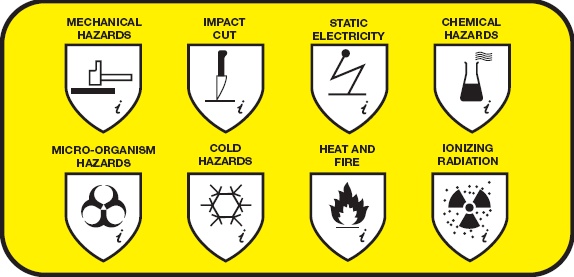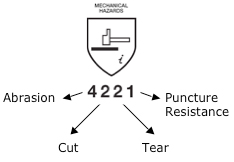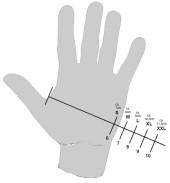Products
Glove Selection Guide
Overview
Most chemicals can damage your skin severely or cause allergic reactions and irritations. Some chemicals can even be absorbed through your skin, causing skin contamination and infection. Skin can also be damaged through extreme heat and constant frictions. Because of these reasons, protection against hazardous materials and chemicals is really important. Given the wide range of applications, gloves must be selected carefully on the basis of the type of work carried out and the materials they are made out of.EN Standards
The most commonly known and most relevant standards for gloves are EN 388 and EN 374. A third standard - the EN 455, is normally used to test gloves for health care purposes. Pictograms or symbols (as seen below) will appear to be marked on the gloves or the boxes if the gloves have passed the tests.
EN 374
Specifies the standards for the protection of the gloves against chemicals and/or microorganisms. It requires that: The gloves need to be sealed against liquids and chemical penetration according to the specified method in EN 374-2. The resistance towards permeation of the gloves are tested according to method EN 374-3. Classification of the gloves is made based on the time it takes for the gloves to resist the permeation of the chemicals.EN 388
Specifies the requirements for the protection of the gloves against physical and mechanical hazards such as perforation, abrasion, and tearing/cutting. The rating underneath the pictogram refer to the gloves protection with respect to: Abrasion (4), Cut (2), Tear (2), Puncture Resistance (1).
EN 455
Specifies the requirements for the protection of the gloves against infection risks. Most commonly applied to the gloves worn in health care.When choosing your gloves, you should always consider these factors:
Hand size
Gloves that are too small can cause rashes or unnecessary hand fatigue. Gloves that are too large can snag, are uncomfortable, and can affect your grip. To ensure maximum protection and efficiency, choose the right size gloves for your hand. Pictured below is a guide for gloves sizing.Which glove size is required?
The correct glove size is important for wearer comfort and convenience during work. To determine the glove size, the hand is placed on a sheet of paper and the contour drawn around it. The width of the hand should be marked, as shown in the diagram, and then measured with a ruler. The dimensions that can be read off on the diagram (when enlarged) indicate the appropriate glove size.Too small a glove should never be selected, since this causes the material to be stretched thinner and the barrier effect to be reduced as a result. Conversely, too large a glove size obstructs work. The correct glove size is therefore important.

Click for full-size

